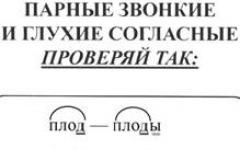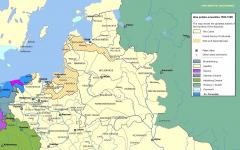Case is a variable characteristic of a word that is inherent only to nouns, adjectives, numerals or pronouns. Considering the above, we can determine the meaning of the term “case”.
Case- this is a characteristic denoting the type in which the noun is found, denoting its relationship with another object or person, defining its action, state or attribute.
A more complex concept of case sounds like this:
Case- a changing characteristic of the grammar of the Russian language, which corresponds to a noun, pronoun, numeral or adjective, as well as their hybrids, determining their meaning in a sentence regarding semantic or syntactic position.
Cases help connect parts of speech with each other, giving a sentence or phrase a certain thought. Visually, it is expressed using text through transformation of the form of the word. For clarity, you can compare:
- month, barns, yellow, face, sun, clear;
The moon hides its yellow face behind the barns from the blazing sun.
In the first case, a set of words is used that are not connected in any way and therefore represent a meaningless enumeration. In the second, the parts of speech are changed, the idea is presented clearly and clearly, this is facilitated by cases.
There are 6 cases in total, which are characterized by a specific ending. A particular case can be determined by asking the appropriate question, or recognized by the presence of certain prepositions. The table presented shows all existing cases, defining their questions and corresponding prepositions, if any.
Case table
Cases in Russian (table with questions and endings)
Before we examine each case separately using specific words as examples, let us once again recall the terminology of this word and relate it to the noun.
Case is a form of a noun that modifies it and reveals its relationship to another object, person, action or event, creating a semantic connection in a sentence or phrase.
Noun cases. Case prepositions
Nominative
Nominative is the basic or initial form of the name of an object. Used to denote an object, in the nominative case the word will always express the answer to the question Who? or What?
- Who? mom-a, hare_, doctor_;
- What? pen, sun, pond, quiet.

Prepositions are not used when using words in the nominative case. It belongs to the direct case category (the rest are called indirect). In a sentence, a noun in the nominative case is the subject or part of the predicate.
- I really liked this book. (« book" in the nominative case, is the subject)
- A dog is man's best friend. (« Friend" - part of the predicate)
Genitive
Denotes the attraction or belonging of an object to another object or person, answers questions whom? what?
- (no) who? mothers, hare, doctor;
- (no) what? handles, suns, ponds, quiet.

This case belongs to the category of indirect and can be used with or without prepositions. Example:
- (missing what?) handles - the (what?) handle broke off.
To more accurately connect the meaning of a noun with another word, prepositions are used. If the noun is in genitive case, then it will correspond to the prepositions without, from, around, with, about, at, after, from, for, to.
- walk without a hat;
- learn from a book;
- walk around the building;
- ask a passerby;
- move away from the entrance;
- reach your shoulder.
Dative
Used in combination with verbs that denote an action in relation to a given subject; questions correspond to it: to whom? or what?
- I give (to whom?) mom-e, hare-y, doctor-y;
- I give (to what?) handle-e, sun-y, pond-y, quiet-y.

This case (which is also indirect) corresponds to the prepositions to (ko), by, according to, contrary to, following, like.
- Run up to your sister;
- act according to conviction;
- go towards the train;
- do against advice.
Accusative
A noun in the accusative case indicates the object of the action, is used in combination with a verb, and questions correspond to it: whom? or What?
- I blame (who?) mom-a, hare-a, doctor-a;
- I blame (what?) handle, sun, pond, quiet.

Prepositions used with a noun in the accusative case: with (with), through, in (in), about (about), on, through, under, about, through, by, for.
- Carry through the years;
- talk to yourself;
- peep through glass;
- dance to music;
- avenged his father.
Some of these prepositions ( on, under, behind, in) clarify the direction of the action being performed:
- hid (what?) in a box;
- put (for what?) on the box;
- put (for what?) per box;
- adjusted (under what?) under the box.
Instrumental case
A noun in the instrumental case denotes an object that produces an effect on another object; it is determined by the questions: by whom? or how?
- Satisfied (with whom?) mom-oh, hare-eat, doctor-oh;
- happy with (what?) pen-oh, sun-oh, pond-oh, quiet-oh.

Prepositions used with a noun in the instrumental case: for, with (co), between, under, above, in front of, together with, in connection with, according to s.
- Speak with pride;
- fly above the ground;
- think before buying;
- look after the child;
- laugh with grandma;
- stand between trees;
- stop due to the rules.
Prepositional
Standing in the prepositional case, a noun answers questions about whom? about what?
- I think (about whom?) about mom, hare, doctor;
- Think about what?) about the pen, about the sun, about the pond, about silence.

Prepositions to use if the noun is in the prepositional case: by, on, about (about), in, at.
- Establish at the department;
- go to the museum;
- sit on a bench;
- talk about the film;
- sail on a boat.
Oh, this declension... When studying a noun, it is this topic that makes you really rack your brain in order to remember all the unstressed endings in all kinds of cases and numbers. How to determine the declension of nouns? The table and examples will make the task easier! Let's try to figure it out and become a little more competent!
What is declination?
Declension of a noun (a table of examples is given in the text) is a change in the case of a word and its number. Let's look at the examples in the table.
The table of declension of nouns by case shows that all nouns are divided into groups depending on what endings they acquire in the form of one case or another. Accordingly, all words related to the same phrase will have the same set of endings. Knowing how to determine the declension, you can avoid mistakes in writing the endings of nouns in a weak position, in other words, not under stress.
How many declensions can a noun have?
The table of declension of nouns by case, given in the previous section, showed that any words of the same declension in the form of the same case will have the same endings. It presents the three most common types of declension of our language. But, as you know, he is very rich, and simple rules does not exist in it. In addition to the three presented, there are other types of declinations.

So, what types of declinations are there? The most common are the first, second and third declension.
A separate group consists of words that end in -ies: intent, crime, agreement, etc.
The next group are words ending with -and I: mania, Natalia, waist, session, commission, etc.
There is a small group of words ending in -me, which are also inflected in a certain way: time, tribe, etc. Such words are called differently inflected nouns (a separate paragraph of the article will be devoted to them). Words such as path and child are also considered indeclinable.
And finally, there are also words that cannot change either by case or number, and “look” the same in all forms. These are indeclinable, or unchangeable, nouns: kangaroo, kiwi and others.
Why do you need to be able to determine declination?
The table will tell us how to determine the declension of a noun a little later. But very often the question arises: why do this? Why remember all these cases, endings, many “special” words that need to be remembered? But for what? Let's take the word "path" as an example: I'm walking along the path, or I'm walking along the path? What should I do? Which letter should I choose? And here's another word: "winter". It too female with the ending -a-. We put in the same case: (to whom? to what?) - WINTER. But we already know that all words of the same declension acquire the same ending when changed. So you need to write like this: I'm walking along(to whom; to what) pathE. The issue is resolved!
How to determine the declension of a noun? The table and examples in the following paragraphs will help you not to make mistakes in this rather simple question!

Nouns of 1st declension
These are the words of a woman and male, which have endings in the initial form -A or -I(remember that the initial form for a noun is nominative and singular).
There are a lot of feminine words with such endings in the Russian language: mom, Masha, pajamas, apartment, work, daughter and many, many others. There are fewer masculine words, but they exist and are very common: dad, grandfather, Vasya, Petya and other male names.
The table of nouns of the 1st declension will compare words with stressed and unstressed endings to show that all words of a given declension will have similar case endings.
Nouns 2nd declension
These are masculine words that have (it is not expressed by a letter in the nominative case, but “appears” in other forms) and neuter gender with the endings -o, -e: raft, horse, lake, sea, field, etc. The table of nouns of the 2nd declension will show which endings the words acquire when changing by case.
As you can see, in the accusative case they have different endings. And only prepositional case forms with an unstressed ending can cause difficulties, so you should remember that in this form you need to write - e.

Nouns of the 3rd declension
These are feminine words with a zero ending. They all end in a soft sign: mouse, brooch, region, passion, and so on. Let's see what endings these words take in different forms.
It is very easy to remember: in the forms of the genitive, dative and prepositional cases, such words acquire the ending - And.
Nouns starting with -и, -я
The word “aspiration” is neuter, but it cannot be attributed to the 2nd declension; the word "mantle" is feminine, but does not change like words of the 1st declension. The table of declension of nouns by case will show the difference in endings.
As can be seen from the table, the words in -ies differ from words of the 2nd declension only in the prepositional case, and words in -and I from words of the 1st declension - in the dative and prepositional.
Remember that words ending in -ya, in all forms behave like words of the 1st declension. Therefore, for example, the forms of the same name Natalia and Natalia will be inclined differently: (give) Natalia, Natalia, (talk) about Natalia, about Natalia.
Table of declension endings for nouns
Let us summarize what has been said with a table of case endings of words belonging to different declensions.
| Case | -1 cl- | -2 cl- | -3 cl- | -ies | -and I |
| I.p. | paw, bullet | __ -o, -e house, dish | |||
| R.p. | paws, bullets | home, dishes | |||
| D.p. | paw, bullet | home, dish | |||
| V.p. | paw, bullet | __ -o/-e house, dish | |||
| etc. | -oh/-ey paw, bullet | -om/-em home, dish | greatness | ||
| P.p. | about the paw, about the bullet | about the house, about the dish | about greatness |
Let's hope that no one will have any difficulty choosing the desired ending and determining the declension of nouns in the Russian language. The table explained everything in great detail.
It should be noted that -ies And -and I cannot be isolated as a separate morpheme, ending. In this case, these are simply the letters with which the word ends. such words are the topic of another article.

Declension of plural nouns (the table here is, in general, unnecessary) very rarely causes difficulties, since the letters are mostly clearly audible. In the dative, instrumental and prepositional cases in the plural, all three declensions will have the same endings. We suggest that you decline any words in the plural yourself and make sure of this.
Indeclinable nouns
There are few indeclinable words among the nouns of the Russian language. Why are they divergent? Because they cannot be attributed to any one declension; in different cases they “behave” differently. These are words ending with -me(there are about ten of them), the words “path” and “child”. Let's look at the features of the declension of nouns in the Russian language (table) - those words that are considered differently indeclinable.
| I.p. | stirrup | path | child |
| R.p. | strem-en-i | put-i | dit-yat-i |
| D.p. | strem-en-i | put-i | dit-yat-i |
| V.p. | stirrup | path | child |
| etc. | rush-en-em | put-em | dit-yat-ey |
| P.p. | o strem-en-i | about the way | oh dit-yat-i |
As you can see, the word “child” is inclined in a very special way. The word "path" in the genitive, dative and prepositional cases "behaves" like a word of the 3rd declension, and in the instrumental - like a word of the 2nd declension. Well, words ending with -me, in indirect cases they acquire the suffix -en-.
You need to remember these words so as not to make a mistake in choosing the right ending.
Unbreakable words
These are mostly borrowed words - coming from other languages. They can indicate the names of animals, plants, dishes, as well as first or last names of people, names of objects. Having entered our language, such words retained the peculiarity of not changing their form when entering a sentence. No matter what case or number such a word should be placed in, it will sound the same.
- Pour me some coffee - I admire morning coffee - we're talking about coffee.
- This is my cockatoo - I don’t have a cockatoo - give food to the cockatoo - remember the cockatoo.
- Dumas' novel - dedicated to Dumas - writes about Dumas.
It is incorrect and ignorant to inflect such words in a sentence. Everyone knows the joke phrase “I’m sitting in the first row of a movie theater with a popiroska in my tooth.” Let's not be like the hero of this joke! Declinable words must be used correctly, but indeclinable words do not need to be changed at all.

Let's sum it up
Determining the declension of nouns (table above) is not a complicated process at all, which will help you avoid mistakes when writing. Let's try to summarize all of the above.
There are three main declensions in the Russian language, but there are also special words ending in -and I And - Yep, and a few different words. Words are divided into three main groups depending on gender and ending in the nominative case.
All words of the same declension have similar endings. They can be learned so as not to make mistakes. Or you can do it differently: instead of a word with an unstressed ending, substitute any word of the same declension, but in which the stress falls on the ending. The letter at the end of these words will be the same!
Words on -and I And -ies are not included in the three main groups, because they change according to cases and numbers in a special way, and they need to be remembered.
You should also remember a small group of differently inflected words. Their set of endings does not coincide with any of the above declensions, which is why they require special attention.
And finally, inflexible words: they do not change, no matter in what context they are used. Decline words such as in a sentence cinema, coat, coffee, purse, kangaroo,- a sign of low literacy and general culture.

We hope that the article was useful and helped to understand such a difficult topic as noun declension. The table and examples were clear, and therefore choosing the correct ending will now not be difficult.
Be literate!
Spelling noun endings
To correctly write unstressed endings of nouns, in most cases (except for words ending in -ИЯ, -ИЭ, -ИИ), it is enough to determine which declension the word belongs to and see how words with stressed endings from the same declension are written in the same form.
When checking for the first declension it is convenient to use the words GRASS, EARTH, for the second - WINDOW, ELEPHANT, for the third - STEPPE, CHAIN. All endings in these words are stressed.
For example, we doubt what to write at the end of the phrase “BLOTS IN A NOTEBOOK_”. The word NOTEBOOK of the third declension. We substitute the test word “IN THE STEPPE”. Therefore, you need to write “BLOTS IN A NOTEBOOK”, with the letter I at the end.
For feminine nouns ending in -Ya, the ending -I is written in the genitive, dative and prepositional cases (ARMYA - from ARMY, to ARMY, about ARMY; NATALIA - from NATALIA, to NATALIA, about NATALIA), for masculine nouns on -ИИ and neuter gender in -И in the prepositional case the ending –И is written (SANATORIY – about SANATORIUM, CONSTELLATION – about CONSTELLATION).
IN ADDITION, PLEASE NOTE THE FOLLOWING RULES GUIDING THE WRITING OF SOME SPECIFIC NOUN FORMS:
1. After the suffixes -USHK-, -YUSHK-, -YSHK-, -ISHK- for feminine nouns and for animate masculine nouns, the ending –A is written, for example: ZIMUSHKA, STRASTISHKA, KUPCHISHCHKA, TRUSISHKA. For neuter nouns and inanimate masculine nouns, after these suffixes the ending -O is written, for example: GORYUSHKO, GOLOSISHKO, MOLOCHISHKO, RUBLISHKO.
2. After the suffix -ISH- the ending -E is written for masculine and neuter nouns in the singular, and for feminine nouns - the ending - A. For example: GIANT, GORODISCH, SWAMP, LOG, BORED, SILISCH. In the plural, after the suffix -ISCH- the ending -I is written for masculine and feminine nouns, and the ending -A for neuter nouns. For example: FENCES, BOOTS, PALM, SWAMPS, WINDOWS.
3. The monosyllabic nouns VIY and KIY have the ending -E in the prepositional case.
4. In personal names and surnames eastern origin ending in -YL and having stress on the last syllable, the ending E is written in the dative and prepositional case: letter to Zulfiya, dream about Aliya (name - Zulfiya, Aliya).
Exercise
Have you heard behind the grove the voice of the night singer of love, the singer of your sadness? (A. Pushkin)
“Hey, shepherds, run here, beat me, beat me!” Shepherds with a club at the wolf, the wolf - from them. The shepherds run and marvel. The wolf is crazy, he runs and shouts: “Catch up!” (Chingiz Aitmatov, White Steamship)
Again I’m on the high road_, poetry_ free - a citizen, again in a nomadic den_ I think alone. (P. Vyazemsky)
There is no pity for my deep melancholy. (E. Baratynsky).
In my memory there were no girlfriends of the old days. (E. Baratynsky)
He slowly climbed the stairs, slowly entered the room among the respectfully parted public, and, greeting his acquaintances, looked around the room questioningly. (I. Bunin)
“The servant of God Victor is engaged to the servant of God Natalie,” Father Vasily proclaimed even louder, almost singing, and, removing the rings from their hands and crossing them, he put his own on each. (Sergey Babayan, Gentlemen officers)
Happy is the one in whom the color of life is not destroyed by the cold. (I. Klyushnikov)
The earth still looks sad, but the air already breathes in spring, and the half-dead stem sways, and the spruce branches move. (F. Tyutchev)
“We can’t, dear sir, we’ll pick around little by little, collect pennies, maybe we’ll sew some money for the kids,” said Filat Nikitich. (F. Reshetnikov, Between People)
Temperament, curiosity, strength - everything in his powerful nature prevents him from settling in the lands he has discovered; he gives them to others, but he himself hurries on. (Daniil Granin, Zubr)
A golden cloud spent the night on the chest of a giant rock; In the morning she set off early, playing happily in the azure. (M. Lermontov).
Sof_ Ivanovna really wanted to go, and we decided to entrust our fate to the nervous coachman. (N. Teffi, Mountains)
Vasily Dimitrievich was married to Vitovt's daughter Sophie: throughout his reign he had to respect family relationships and at the same time was on guard against his father-in-law's attempts. (N. Kostomarov, Russian history in the biographies of its main figures)
Whether you are in stormy poetry, sometimes gloomy, sometimes bright. (F. Tyutchev).
In this excitement, in this radiance, all as if in a dream, I stand lost; Oh, how willingly I would drown my entire soul in their charm. (F. Tyutchev).
And the wine farmer Mamontov was selling the same rotten stuff as it was ten years ago, under Vasily Aleksandrovich Kokorev. (N. Leskov, Life of a Woman)
I'm tired of girls, alone in the room, sewing patterns with silver. (K. Aksakov)
In the house and in the neighborhood, everything, from the yard girls to the yard dogs, ran away when they saw him (N. Gogol)
Fires, rumpled bushes, black, still smoking ruins flashed by. (Yu. Dombrovsky, The Monkey Comes for His Skull)
And the tired traveler grumbled at God: he was thirsty and hungry, wandering in the desert for three days and three nights... (A. Pushkin).
Behind the church, across the passage, lay a concrete building, covered in glass and aluminum. (Yu. Druzhnikov, Visa the day before yesterday)
I noticed, braced myself, and then suddenly, to my misfortune (or perhaps fortunately!), out of the blue the repairman galloped onto our little town. (F. Dostoevsky, Polzunkov)
Thoughtfully and in some kind of senseless reasoning about the strangeness of his situation, he began to pour the tea (N. Gogol).
In fact, it was Skvorushk_, a very young yellow-throated one: he didn’t even know that such caterpillars were not eaten, and was very proud of his prey. (Boris Zakhoder, Fairy Tales for People)
Class: 5
Presentation for the lesson
Back forward
Attention! Slide previews are for informational purposes only and may not represent all the features of the presentation. If you are interested in this work, please download the full version.
Basic tutorial Russian language. 5th grade. Textbook for general education institutions. In 2 hours. Part 2 / T.A. Ladyzhenskaya, M.T. Baranov, L.A. Trostentsova and others; scientific editor N.M. Shansky. – M.: Education, 2012.
The purpose of the lesson: become familiar with the spelling of noun endings in -iya, -ie, -iy singular in genitive, dative and prepositional cases
Planned results:
- Subject Skills:
- drawing up an algorithm for writing e-And in case endings of nouns; knowledge of the method of action when choosing the spelling of letters e-i at the endings of nouns;
- mastery of this method of action; determining case endings of nouns
- correct application of the rule in writing;
- Meta-subject skills:
- mastering techniques for selecting and systematizing material;
- adequate comprehension of the text by ear;
- the ability to argue your thoughts when answering;
- the ability to freely and correctly express one’s thoughts orally and in writing;
- Personal skills:
- the ability to evaluate one’s own activities and the activities of classmates;
- desire for speech self-improvement;
- the ability to self-assess one’s own speech in terms of communication norms
Lesson type: lesson in learning new knowledge
Forms of student work: steam room, group, individual
Required technical equipment: computer class for 7 people, multimedia projector, interactive whiteboard
Lesson structure and flow
| Teacher activities | Student activities |
Training and development tasks for each stage |
Diagnostic tasks of each stage. UUD |
||
| I. Organizing time(motivation to educational activities)
(1 min.) Purpose of the stage: inclusion of students in activities at a personally significant level |
|||||
| Greetings, checking readiness for the lesson, wishes for success. Getting into the business rhythm. |
Choose an emoticon and show your mood. | - Good afternoon guys! On the tables you have emoticons No. 1, 2, 3, choose the one that matches your mood and show it. – How many smiles lit up. Thank you! And this is my mood ( Slide 2) – I see: we are ready for active and productive cooperation. Good luck to all! |
– Why is the mood in class so important? Personal results Self-determination (L) Meta-subject results Planning educational collaboration with teacher and peers (K) |
||
| II. Updating and trial learning activity(4-5 min.) Purpose of the stage: repetition of the studied material necessary for the “discovery of new knowledge”, identification of difficulties in the individual activities of each student; preparing students' thinking and organizing their awareness of the internal need to build a new way of action. |
|||||
| Organizes repetition of knowledge, consolidation of skills | Complete tasks, identifying the extra word, analyzing all the words | (Students work in groups of 3) (Slide 3) – Find the "third wheel" word in each group: 1) about the people _, to the crown _, without clouds _ 1 group: the extra word “without a cloud”, since, unlike other words, it is in R.p. and has the ending - And. The first two words, despite different declensions (2 and 1) and cases (P. and D.), have - e. 2nd group: all nouns are pp., but the first two words belong to the 1st declension, so in the ending - e, and “spruce” – 3 declensions, ending - And. So, the extra word “about spruce” 3 group: all nouns P.p., ending in 1st and 2nd declensions - e. Noun « building" s.r., 2 declensions - means, too - e? 4 group: all nouns of the 1st declension, D.p., ending -e. |
– What role does knowledge of the Russian language play in your life? What do you need them for? Meta-subject results |
||
| III. Problematic explanation of new knowledge(15 minutes.) Purpose of the stage: discussing difficulties (why difficulties arose, what we do not yet know), ensuring students’ perception, comprehension and initial consolidation that nouns in -i, -i, -iy are special nouns; |
|||||
| drawing up an algorithm for its determination, setting goals for educational activities Creates a problematic situation (offers a task that is not feasible due to the lack of knowledge) and organizes the work of students to study it. |
Involves students in discussing problematic issues, determining the purpose and topic of the lesson Participate in discussion problematic issues formulate their own opinion and give reasons for it |
Set a goal, formulate a problem and topic of the lesson Formulation of the problem (2 minutes.) |
- So, the topic of the lesson... – Why did opinions differ? What is the problem?. | ||
| (We don't know which letter to write at the end) |
Organizes work in groups, pairs, ensures control over the completion of tasks Study the information in the textbook, p. 69 screenshot and performance (pair work) |
Create an action algorithm (group work) Opening new (10 min) 1. Formulating a problematic question on a new topic 2. Study the material in the textbook on p. 69. (Slide 5)
3. Report on the assignment completed at home: working with an information-type electronic training module. Performance. (Slide 6)
4. Drawing up an algorithm for determining the unstressed ending of nouns ending in -i, -ie, -i (they work in a group for 2 minutes, then one of the groups speaks, the others make adjustments)
|
– Formulate a problematic question and compare theoretical information on new topic, obtained from EER, with material in the textbook Meta-subject results |
||
| Organizes physical training | Do physical exercises | Fizminutka - And now everyone is up! |
|||
| IV. Consolidation of what has been learned Purpose of the stage: speaking and consolidating new knowledge; identifying gaps in the primary understanding of the studied material, students’ misconceptions; carrying out correction; |
|||||
| learning to spell the endings of nouns in -i, -i, -i. | Establishes awareness of perception, makes a primary generalization. Working with a textbook. Exercise mutual control and provide the necessary mutual assistance in cooperation (work in pairs). They participate in the discussion of problematic issues, formulate their own opinions and give reasons for them. |
Give self-assessment to the results of their educational activities (work in pairs, individually) Primary consolidation(Slide 8) And. |
– Write down the words with gaps, indicating the endings in them. Meta-subject results – What is the difference in the spelling of nouns? Control, correction, selection and awareness of what has been learned (R) Rating (P) Managing your partner's behavior (K) Subject results Expressing your thoughts with sufficient completeness and accuracy (K) Action by analogy (P) Ability to structure knowledge, select the most effective ways Personal results problem solving (P – general education) |
||
| Self-determination (L) Organizes activities to apply new knowledge, incorporate new knowledge into the knowledge system and repeat |
Introduces students to work with electronic educational resources Incorporating new things into the knowledge system and repeating them(Slide 10) Work on options with mutual checking “Spelling of unstressed endings of nouns” (Handout) ( ) Annex 1 Independent work to control knowledge Working with the author's electronic training simulator of the control type "Letters E-I in the endings of nouns" with automatic grading (students enter their last name, class and date of work on 1 sheet; the teacher records the final result) ( Appendix 2 ) |
||||
| V. Lesson summary (reflection on activity) Purpose of the stage: students’ awareness of their educational activities, self-assessment of the results of their own and the entire class’s activities |
|||||
| Organizes reflection and self-assessment of student results Offers homework taking into account the students' level of preparation |
Carry out lesson assessment and self-assessment, correlate the goal and results, the degree of their compliance Answer the questions: |
(Slide 12) – What was your goal? – Did you manage to achieve your goal? - How? – What results did you get? – What caused particular difficulties? – Where can you apply new knowledge? – Name the keywords of the topic. – Select the emoji that matches your mood, and show it. (Slide 13) Homework assignment. 1) Execute – exercises 540, 542 (one to choose from); – test No. 5, options 1,2, tasks 1–4, p. 17, 19 (book “Tests. Part 2”). 2) Advanced level task: starting to study in English, we learn that there are almost no cases in this language. Maybe in the Russian language cases are a completely unnecessary thing? Question. Is it so? Use a simple example to prove the need for cases. (Slide 14) Thanks for the work. |
– Compare your mood at the beginning and end of the lesson. – What does this have to do with? Meta-subject results |
||
Bibliography:
- Blinov G.I., Antokhina V.A. Collection of dictations on spelling and punctuation: A manual for teachers.
- – M.: Education, 1986. Efremova E.A. Russian language. Workbook. Grade 5 /Student Guide educational institutions
- . – M.: “Enlightenment”, 2012. Knigina M.P.
- Russian language. 5th grade. Tests: At 2 o'clock. Part 2. – 2nd ed., revised. and additional – Saratov: “Lyceum”, 2010. Mezhueva Yu.V.
- Russian language. Spelling of case endings of nouns - Saratov: “Lyceum”, 2010.
- Russian language. 5th grade. Textbook for general education. institutions. In 2 hours. Part 2 / T.A.Ladyzhenskaya, M.T.Baranov, L.A.Trostentsova and others; scientific editor N.M.Shansky /. – M.: Education, 2012.
Information type electronic training module:
Table 1 - Case endings of singular nouns
| Cases | I declension | II declension | III declension |
|---|---|---|---|
| I. p. | -and I
wives A, earth I | ,
-o, -e
horse, sat down O, floor e |
night, horse |
| R. p. | -s, -i
wives s, earth And | -and I
con I, sat down A, floor I | -And
night And, horses And |
| D. p. | -e
wives e, earth e | -u, -yu
con Yu, sat down at, floor Yu | -And
night And, horses And |
| V. p. | -u, -yu
wives at, earth Yu | , -a, -i, -o, -e
con I, sat down O, floor e |
night, horse |
| etc. | -oh (-oh), -ey (-her)
wives Ouch, earth to her | -om, -eat
con eat, sat down ohm, floor eat | -yu
night yu, horses yu |
| P. p. | -e
wives e, earth e | -e, -i
con e, sat down e, floor e | -And
night And, horses And |
In singular case endings it is written:
- letter e : in the dative and prepositional cases of nouns of the 1st declension and in the prepositional case of the 2nd declension (except for words in -and I , -th , -ies ), For example: to factories e, to factories e, to the ground e, about the battery e, to become e; to factory e, to the machine e; about pestilence e; all L e;
- letter And
:
- in the genitive case of nouns of the first declension, for example: at the factories And, near the ground And, near the battery And, from becoming And;
- in the prepositional case of nouns of the II declension on -ies , -th , For example: in the lecture hall And, in excitement And, about worldview And ;
- in the genitive, dative and prepositional cases of nouns of the first declension in -and I , nouns of the third declension and heterodeclinable neuter nouns on -me , For example: from the collection And, to the collection And, in the collection And; from overcoats And, to the overcoat And, in an overcoat And; at the banners And, to the banners And, about the banner And.
It is necessary to distinguish between the forms of the prepositional case of neuter nouns on -ies And -ye , For example: be in thought And, be fully prepared And (ending -And ); be in thought e, be on the coast e (ending -e ).
Case endings in surnames and titles
In Russian surnames -in(-yn) and on -s(-s) in the instrumental case the singular is written -th (like adjectives), for example: with Vyacheslav Demin th, with Rostislav Sinitsyn th, with Kirill Kolosov th . The ending is written in foreign surnames -ohm , For example: Darwin ohm, Chaplin ohm .
In titles settlements on -in(-yn) , -s(-s) , -ino(-ino) , -ovo(-evo) in the instrumental case the singular ending is written -ohm (as in nouns), for example: near the city of Kashin ohm, Borodin village ohm, the city of Dmitrov ohm .
Case endings for plural nouns
Table 2 - Case endings of plural nouns
| Cases | I declension | II declension | III declension |
|---|---|---|---|
| I. p. | -s, -i
wives s, earth And | a, -i, -s, -i
con And, sat down A, floor I | -And
night And, horses And |
| R. p. |
wives, lands | -ov, -ey,
con to her, sat down, floor to her | -to her
night to her, horses to her |
| D. p. | -am, -yam
wives am, earth yam | -am, -yam
con yam, sat down am, floor yam | -am, -yam
night am, horses yam |
| V. p. | -s, -i,
wives, land And | -a, -i, -s, -i, her, -ov
con to her, sat down A, floor I | -and, -ey
night And, horses to her |
| etc. | -ami, -yami
wives ami, earth yami | -ami, -yami
con yami, sat down ami, floor yami | -ami, -yami
night ami, horses yami |
| P. p. | -ah, -yah
wives Oh, earth I | -ah, -yah
con I, sat down Oh, floor I | -ah, -yah
night Oh, horses I |
- In the genitive plural, after the sibilants, the letter b is not written, for example: solution tasks, repair dwellings.
- In the genitive plural of nouns -ya
And -ye
in unstressed position it is written -th
, under stress - -to her
, For example: liar th(liar), delusion th(meditation), But stat to her(article), scam to her(bench). Exceptions: Rouge to her(gun), pay ev(dress), ust ev(mouth), upper reaches ev(upstream), downstream ev(lower reaches).
In nouns -and I , -ies in the genitive case it is always written -th , For example: lin th(line), building th(building). - If nouns in the genitive plural end in -en , then the soft sign is not written, for example: songs, cherries ( Wed apple trees, kitchens). After -en letter in the genitive case b written in words villages b, young ladies b .












